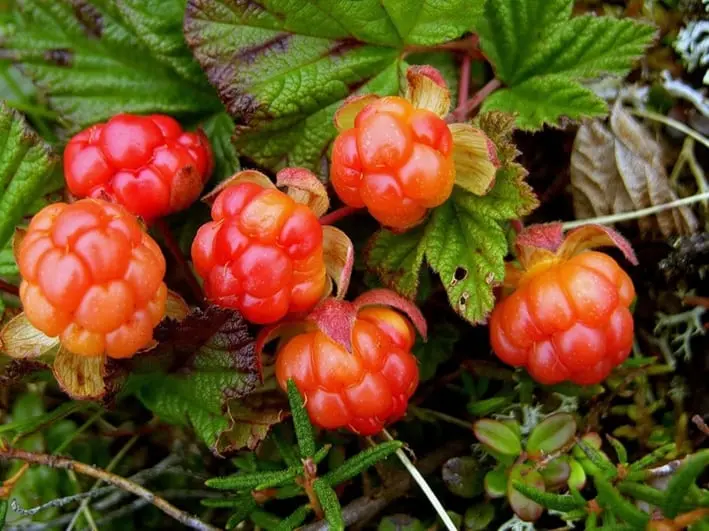Contents
- Photos, description, and chemical composition of cloudberry
- How to recognize a cloudberry
- Cloudberry – where does it grow?
- Cloudberry grows in places where such plants grow:
- Interesting facts
- Useful properties
- Useful properties of leaves, roots, and juice
- Cloudberry leaves are used to achieve the following:
- Cloudberry roots are most commonly used to treat:
The medicinal properties of cloudberries are well known, and it’s not a secret to anyone. It is notable for its multiple beneficial properties. Mainly, for the cloudberry’s healing power, Alexander Pushkin, the great Russian poet, loved to eat it. He loved it so much that he asked his wife to bring him some soaked cloudberries even before he died. Nowadays, diseases recede as soon as berries enter the body.
Photos, description, and chemical composition of cloudberry

Cloudberry belongs to the so-called type of perennial, rather rare herbaceous plants. It belongs to the genus Rubus, in simple words – raspberries, the name of the family – Pink. The correct Latin name is Rubus chamaemorus. The fruit of the cloudberry is suitable for consumption, both raw and processed. The specific name comes from the Greek language; it simultaneously personifies the berry itself and the plant’s name.
Cloudberry is such a valuable berry that it has legal protection in Poland. The berry had multiple name options:
- swamp amber;
- eyes;
- guard;
People were also calling this berry: moss currant, northern orange, arctic raspberry.
How to recognize a cloudberry
Rhizome type – creeping; height – up to 30 cm. It is a herbaceous semi-shrub plant, which is a key characteristic, with thin erect stems. On stems, there are 2-3 leaves. There is 1 flower at the top of the plant; petals are white. It has leaves with wrinkles, round in appearance, feature – reniform, and five lobes. The edges are uneven. Fruit picking begins in July and ends in August. The roots harvest time is late autumn.
We may divide flowers into male and female. The flowering period is June-July. Fruit ripening time is up to 45 days. The berry is very similar in appearance to raspberries, only with a different smell and characteristic taste. Ripening indicator – the amber color of berries may appear to be orange; have a high degree of transparency. Unripe berries are different in color – they are yellow-red and easy to recognize.
Cloudberry – where does it grow?

It grows in northern latitudes, occurs in marshy areas and mountainous areas. Most often, the berry grows in swampy forests and also close to peat bogs. Cultivation is carried out at times.
Cloudberry grows in places where such plants grow:
- lingonberry;
- crowberry;
- blueberries;
- blueberry;
- wild rosemary;
- sphagnum moss.
Indirect signs of places where cloudberries can grow are their inhabitants. And it is in such places that wood grouses, and ptarmigan live – the favorite pastures of these birds.
Interesting facts
All the beneficial and nutritional properties of cloudberries and contraindications to its intake are below. Describing the general noble properties, we can highlight the following points:
Cloudberries contain 4 times more vitamin C than oranges.
The traditional forms to consume the of berries are fresh, jam, drink.
In Sweden and Finland, berry liqueur is very popular to produce; tourists really love it. Landing on cloudberry flowers, bees can collect a lot of honey, nectar, and pollen.
Due to its softness, the berry is better than its counterpart in a slightly unripe state. When overripe, transportation is problematic.
It is interesting to know that in Norway, the government has banned the harvest of unripe cloudberries. Another Norwegian law – anyone can pick the berry, even in state forests. However, only residents have the right to transport delicacies. Guests must consume delicious berries directly in the forest.
Considering the chemical composition of the cloudberry berry, it is possible to distinguish such substances as sugar, Christmas trees, and fiber. The inside of the berry contains organic acids such as malic acid and citric acid. Contains vitamins C, B, PP, A. The list of contained minerals is quite extensive – potassium, phosphorus, iron, a lot of phosphorus and anthocyanins, tannins, and pectin substances.
Useful properties

It is difficult to overestimate the medical value of this berry. For medicinal purposes, this berry is great, particularly in dietary nutrition and for complex recovery. With the help of cloudberries, you can have a beneficial effect on cardiovascular diseases and, importantly, gastrointestinal disorders. Cloudberries also cure burns and skin diseases.
Interesting fact! Cloudberry will work as an anti-febrile remedy if the body has been poisoned with heavy metals.
Another curious fact is that cloudberries contain more vitamin A than carrots. That is why the berry has an antimicrobial effect. Additionally, it has diaphoretic and antispasmodic properties. Also, cloudberry can heal the body of a pregnant woman.
In the case of regular cloudberries consumption, the pregnancy should go without complications, and the risk of harm to the child is minimal. This is because cloudberries contain vitamin E. If you use the berry to treat vitamin deficiencies and hypovitaminosis, you can quickly achieve significant relief from the human condition.
The cloudberry has such useful properties as a diuretic effect. As a thirst quencher, cloudberries can be helpful during periods of colds. Weakened patients often include cloudberries with honey in their diet. Thanks to the strengthening effect, cloudberry helps to coagulate blood.
It is not recommended to take cloudberries with seasonal exacerbations of stomach ulcers. The same is valid for people with gastritis and duodenal problems, especially for gastritis patients with high acidity. People who suffer from the recurrence of such diseases should postpone the intake of cloudberries.

Useful properties of leaves, roots, and juice
Nature does not waste materials. All trace elements are useful in one way or another, not to mention such a useful plant as cloudberries. Its leaves, juice, and roots also may help to heal the body fully or locally.
Cloudberry leaves are used to achieve the following:
- astringent;
- wound healing;
- anti-inflammatory;
- hemostatic;
- diuretic.
With the help of a decoction of the leaves, ascites can be treated. Often, cloudberry leaves are used as a component, an auxiliary for treating many unpleasant diseases. Among such diseases, we may name diarrhea, dropsy, cystitis, gout. With the help of leaves, you can eliminate the disturbed metabolism in the body.
An infusion of the leaves can stop internal bleeding. Also, the leaves, together with berries, can be used to treat cancer. Cloudberry is also used to combat low-acid gastritis.
Cloudberry roots are most commonly used to treat:

- kidney stone disease;
- avitaminosis;
- metabolic disorders;
- colds;
- malaria.
The roots are also good as a diuretic. Cloudberry juice helps to relieve the condition of the affected skin area with scabies. Cloudberry is very effective as a remedy for the treatment of long non-healing wounds of the patient. Moreover, in addition to leaves, roots, and berries, they can treat sepals. Cloudberry is also able to cure a disease such as scurvy.
The recipe for treating festering wounds is to lubricate the leaves with fish oil and then apply it to the skin’s affected area. Using the leaves in this way can speed up the process of removing pus from the wounds. To achieve the maximum effect, it is necessary to change the leaves at least 2 times a day.









